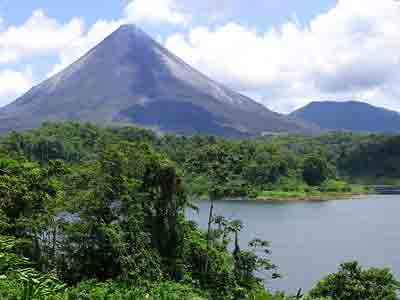About the Arenal Volcano
Courtesy of Mt. Arenal Observatory

At roughly 7:30 a.m. on Monday, July 29, 1968, after having lain relatively dormant for over 400 years, Arenal Volcano erupted with violence and fury. Extreme eruptions and volcanic activity continued for several days, killing some 87 persons and burying over 15 square kilometers (nine miles) in rock, lava and ash. In total, the eruptions affected over 232 square kilometers (140 miles) in the surrounding area to varying degrees, with damage to crops, property, livestock and forests. At the height of this activity, the volcano was throwing out massive amounts of lava and ash, and tossing giant rocks for distances of up to a mile at speeds of some 600 meters per second. The explosions formed three new and active craters.
Since that time, Arenal Volcano has maintained nearly constant activity that ranges from soundless explosions with large mushroom-shaped clouds of ash overhead, to booming explosions that send hot rocks nearly a kilometer into the air, to pyroclastic explosions highlighted by the rush and flow of lava and gases down the side of the volcano. Arenal Volcano rises to approximately 1,633 meters (roughly 5,000 feet) at its summit, although the exact summit height changes frequently due to the volcanic activity. The last major eruptions occurred on May 8, 1998, and gave rise to temporary evacuations from area hotels, although the danger quickly passed and no one was injured.
The Hotel Villa Decary is located a safe 14 miles from the volcano. We are favored by the winds, protecting us from volcanic fumes and ash.
Prior to the 1968 eruption, Arenal Volcano was a nearly perfect conically-shaped, rain forest-covered volcanic mountain with minor fumerole activity. Local residents had named it variously: Arenal Peak, Pan de Azúcar (Sugarloaf), Canasta Volcano, and Río Frío Volcano. The area around Arenal Volcano has been the home of indigenous populations for thousands of years. Over this time, these residents have suffered scores of periods of intense volcanic activity.
In geological terms, Arenal Volcano is relatively young, only some 4,000 years old. Prior to the 1968 eruption, the volcano's last major eruption has been dated at around 1500 A.D., and lava flows from that period have been tentatively identified.

